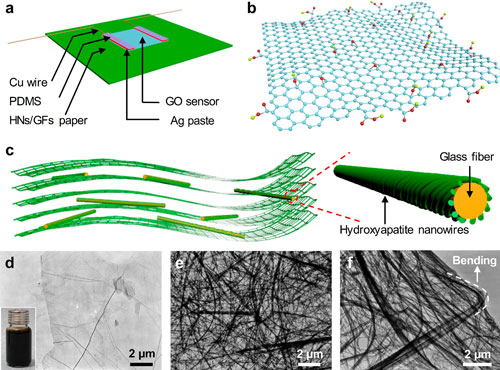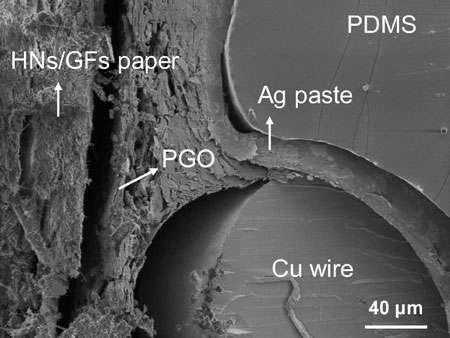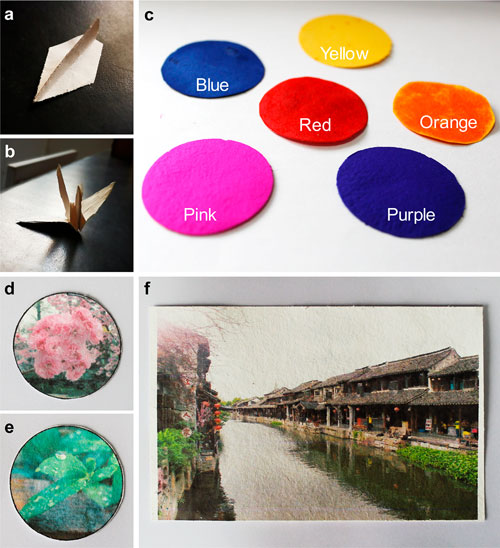Posted: Mar 21, 2018
(Nanowerk Spotlight) Imagine you are fast asleep in your bedroom when a fire breaks out somewhere else in your house. Fortunately, you have nanotechnology-enhanced wallpaper that detects the fire and automatically rings an alarm.
Sounds far-fetched? Well, researchers in China have just developed exactly that.
Reporting their findings in ACS Nano ("Fire Alarm Wallpaper Based on Fire-Resistant
Hydroxyapatite Nanowire Inorganic Paper and Graphene Oxide Thermosensitive Sensor"), scientists from the Shanghai Institute of Ceramics have developed a 'smart' wallpaper based on highly flexible fire-resistant inorganic paper embedded with ultralong hydroxyapatite nanowires that serve as the substrate and graphene oxide as the thermosensitive sensor.
 Schematic illustration of fire alarm wallpaper. (a), graphene oxide (GO) with abundant oxygen-containing groups (b), and HN/GF (hydroxyapatite nanowires/glass fiber) paper with multilayered structure (c). (d) Transmission electron microscopy (TEM) image of GO. Inset: Digital image of the stable GO aqueous ink. (e,f) TEM images of HNs. (Reprinted with permission by American Chemical Society) (click on image to enlarge)
As a first step for their wallpaper, the team fabricated fire-resistant inorganic paper as a multilayered structure: An interwoven network of ultralong hydroxyapatite nanowires (with lengths of more than 100 microns and diameters of about 10 nm) is reinforced with glass fibers that wrap around the nanowires, resulting in a core-shell composite structure.
As the authors explain, "After the paper-making process, hydroxyapatite nanowires and glass fibers are assembled into a well-defined multilayered structure spontaneously, which may be explained by the mechanical equilibrium between physical and chemical forces. The nacre-like multilayered structure is regarded as an effective strategy to balance the strength and toughness."
To prepare the thermosensitive sensor, the researchers prepared a graphene oxide ink, which they drop-casted onto the paper. Finally, copper wires are connected to the two edges of the graphene oxide thermosensitive sensor as external electrodes with the help of silver paste and PDMS.
Schematic illustration of fire alarm wallpaper. (a), graphene oxide (GO) with abundant oxygen-containing groups (b), and HN/GF (hydroxyapatite nanowires/glass fiber) paper with multilayered structure (c). (d) Transmission electron microscopy (TEM) image of GO. Inset: Digital image of the stable GO aqueous ink. (e,f) TEM images of HNs. (Reprinted with permission by American Chemical Society) (click on image to enlarge)
As a first step for their wallpaper, the team fabricated fire-resistant inorganic paper as a multilayered structure: An interwoven network of ultralong hydroxyapatite nanowires (with lengths of more than 100 microns and diameters of about 10 nm) is reinforced with glass fibers that wrap around the nanowires, resulting in a core-shell composite structure.
As the authors explain, "After the paper-making process, hydroxyapatite nanowires and glass fibers are assembled into a well-defined multilayered structure spontaneously, which may be explained by the mechanical equilibrium between physical and chemical forces. The nacre-like multilayered structure is regarded as an effective strategy to balance the strength and toughness."
To prepare the thermosensitive sensor, the researchers prepared a graphene oxide ink, which they drop-casted onto the paper. Finally, copper wires are connected to the two edges of the graphene oxide thermosensitive sensor as external electrodes with the help of silver paste and PDMS.
 SEM image of the cross section of the fire alarm wallpaper based on the fire-resistant HNs/GFs paper and the PGO thermosensitive sensor. (Reprinted with permission by American Chemical Society)
At room temperature, the graphene oxide thermosensitive sensor is in a state of electrical insulation; however, it becomes electrically conductive at high temperatures.
After being exposed to the flame, the high temperature induces instantaneous deoxygenation of the graphene oxide thermosensitive sensor, leading to the rapid transformation from the electrical insulation state to an electrically conductive one; thus, the alarm lamp and buzzer connected to the thermosensitive sensor are able to send out the alarms immediately.
In addition, polydopamine is used as both a reductant and a capping agent to simultaneously improve the responsive sensitivity and flame retardancy of the graphene oxide thermosensitive sensor.
The polydopamine-modified graphene oxide (PGO) thermosensitive sensor exhibits a low thermal
responsive temperature (126.9°C), rapid response time (2 seconds), and long alarm time in the flame (at least 5 minutes).
Compared with commercial wallpapers, the smart fire alarm wallpaper based on PGO is superior owing to the excellent nonflammability and high-temperature resistance of hydroxyapatite nanowires, which can protect the thermosensitive sensor from flames.
SEM image of the cross section of the fire alarm wallpaper based on the fire-resistant HNs/GFs paper and the PGO thermosensitive sensor. (Reprinted with permission by American Chemical Society)
At room temperature, the graphene oxide thermosensitive sensor is in a state of electrical insulation; however, it becomes electrically conductive at high temperatures.
After being exposed to the flame, the high temperature induces instantaneous deoxygenation of the graphene oxide thermosensitive sensor, leading to the rapid transformation from the electrical insulation state to an electrically conductive one; thus, the alarm lamp and buzzer connected to the thermosensitive sensor are able to send out the alarms immediately.
In addition, polydopamine is used as both a reductant and a capping agent to simultaneously improve the responsive sensitivity and flame retardancy of the graphene oxide thermosensitive sensor.
The polydopamine-modified graphene oxide (PGO) thermosensitive sensor exhibits a low thermal
responsive temperature (126.9°C), rapid response time (2 seconds), and long alarm time in the flame (at least 5 minutes).
Compared with commercial wallpapers, the smart fire alarm wallpaper based on PGO is superior owing to the excellent nonflammability and high-temperature resistance of hydroxyapatite nanowires, which can protect the thermosensitive sensor from flames.
 (a,b) As-prepared fire-resistant HN/GF inorganic paper can be folded into complex shapes such as a paper airplane (a) or paper crane (b). (c) Fire-resistant HN/GF paper sheets dyed with different colors. (d-f) Various colorful patterns and images can be printed on the fire-resistant HN/GF paper using a commercial printer. (Reprinted with permission by American Chemical Society)
Other desirable features of this nanotechnology wallpaper include environmental friendliness, white color, mechanical robustness, and high flexibility.
The smart fire alarm wallpaper reported by the Chinese team can be processed into various shapes, dyed with different colors, and printed with the commercial printer, thus it is promising for applications such as high-safety interior decoration of houses.
Overall, the as-prepared smart fire alarm wallpaper provides insights into the design and preparation of flame-retardant materials with smart responsive behaviors and broadens the applications of the ultralong hydroxyapatite nanowire-based fire-resistant inorganic paper and graphene-related materials.
By
Michael is author of three books by the Royal Society of Chemistry:
Nano-Society: Pushing the Boundaries of Technology,
Nanotechnology: The Future is Tiny, and
Nanoengineering: The Skills and Tools Making Technology Invisible
Copyright ©
Nanowerk
(a,b) As-prepared fire-resistant HN/GF inorganic paper can be folded into complex shapes such as a paper airplane (a) or paper crane (b). (c) Fire-resistant HN/GF paper sheets dyed with different colors. (d-f) Various colorful patterns and images can be printed on the fire-resistant HN/GF paper using a commercial printer. (Reprinted with permission by American Chemical Society)
Other desirable features of this nanotechnology wallpaper include environmental friendliness, white color, mechanical robustness, and high flexibility.
The smart fire alarm wallpaper reported by the Chinese team can be processed into various shapes, dyed with different colors, and printed with the commercial printer, thus it is promising for applications such as high-safety interior decoration of houses.
Overall, the as-prepared smart fire alarm wallpaper provides insights into the design and preparation of flame-retardant materials with smart responsive behaviors and broadens the applications of the ultralong hydroxyapatite nanowire-based fire-resistant inorganic paper and graphene-related materials.
By
Michael is author of three books by the Royal Society of Chemistry:
Nano-Society: Pushing the Boundaries of Technology,
Nanotechnology: The Future is Tiny, and
Nanoengineering: The Skills and Tools Making Technology Invisible
Copyright ©
Nanowerk
 Schematic illustration of fire alarm wallpaper. (a), graphene oxide (GO) with abundant oxygen-containing groups (b), and HN/GF (hydroxyapatite nanowires/glass fiber) paper with multilayered structure (c). (d) Transmission electron microscopy (TEM) image of GO. Inset: Digital image of the stable GO aqueous ink. (e,f) TEM images of HNs. (Reprinted with permission by American Chemical Society) (click on image to enlarge)
As a first step for their wallpaper, the team fabricated fire-resistant inorganic paper as a multilayered structure: An interwoven network of ultralong hydroxyapatite nanowires (with lengths of more than 100 microns and diameters of about 10 nm) is reinforced with glass fibers that wrap around the nanowires, resulting in a core-shell composite structure.
As the authors explain, "After the paper-making process, hydroxyapatite nanowires and glass fibers are assembled into a well-defined multilayered structure spontaneously, which may be explained by the mechanical equilibrium between physical and chemical forces. The nacre-like multilayered structure is regarded as an effective strategy to balance the strength and toughness."
To prepare the thermosensitive sensor, the researchers prepared a graphene oxide ink, which they drop-casted onto the paper. Finally, copper wires are connected to the two edges of the graphene oxide thermosensitive sensor as external electrodes with the help of silver paste and PDMS.
Schematic illustration of fire alarm wallpaper. (a), graphene oxide (GO) with abundant oxygen-containing groups (b), and HN/GF (hydroxyapatite nanowires/glass fiber) paper with multilayered structure (c). (d) Transmission electron microscopy (TEM) image of GO. Inset: Digital image of the stable GO aqueous ink. (e,f) TEM images of HNs. (Reprinted with permission by American Chemical Society) (click on image to enlarge)
As a first step for their wallpaper, the team fabricated fire-resistant inorganic paper as a multilayered structure: An interwoven network of ultralong hydroxyapatite nanowires (with lengths of more than 100 microns and diameters of about 10 nm) is reinforced with glass fibers that wrap around the nanowires, resulting in a core-shell composite structure.
As the authors explain, "After the paper-making process, hydroxyapatite nanowires and glass fibers are assembled into a well-defined multilayered structure spontaneously, which may be explained by the mechanical equilibrium between physical and chemical forces. The nacre-like multilayered structure is regarded as an effective strategy to balance the strength and toughness."
To prepare the thermosensitive sensor, the researchers prepared a graphene oxide ink, which they drop-casted onto the paper. Finally, copper wires are connected to the two edges of the graphene oxide thermosensitive sensor as external electrodes with the help of silver paste and PDMS.
 SEM image of the cross section of the fire alarm wallpaper based on the fire-resistant HNs/GFs paper and the PGO thermosensitive sensor. (Reprinted with permission by American Chemical Society)
At room temperature, the graphene oxide thermosensitive sensor is in a state of electrical insulation; however, it becomes electrically conductive at high temperatures.
After being exposed to the flame, the high temperature induces instantaneous deoxygenation of the graphene oxide thermosensitive sensor, leading to the rapid transformation from the electrical insulation state to an electrically conductive one; thus, the alarm lamp and buzzer connected to the thermosensitive sensor are able to send out the alarms immediately.
In addition, polydopamine is used as both a reductant and a capping agent to simultaneously improve the responsive sensitivity and flame retardancy of the graphene oxide thermosensitive sensor.
The polydopamine-modified graphene oxide (PGO) thermosensitive sensor exhibits a low thermal
responsive temperature (126.9°C), rapid response time (2 seconds), and long alarm time in the flame (at least 5 minutes).
Compared with commercial wallpapers, the smart fire alarm wallpaper based on PGO is superior owing to the excellent nonflammability and high-temperature resistance of hydroxyapatite nanowires, which can protect the thermosensitive sensor from flames.
SEM image of the cross section of the fire alarm wallpaper based on the fire-resistant HNs/GFs paper and the PGO thermosensitive sensor. (Reprinted with permission by American Chemical Society)
At room temperature, the graphene oxide thermosensitive sensor is in a state of electrical insulation; however, it becomes electrically conductive at high temperatures.
After being exposed to the flame, the high temperature induces instantaneous deoxygenation of the graphene oxide thermosensitive sensor, leading to the rapid transformation from the electrical insulation state to an electrically conductive one; thus, the alarm lamp and buzzer connected to the thermosensitive sensor are able to send out the alarms immediately.
In addition, polydopamine is used as both a reductant and a capping agent to simultaneously improve the responsive sensitivity and flame retardancy of the graphene oxide thermosensitive sensor.
The polydopamine-modified graphene oxide (PGO) thermosensitive sensor exhibits a low thermal
responsive temperature (126.9°C), rapid response time (2 seconds), and long alarm time in the flame (at least 5 minutes).
Compared with commercial wallpapers, the smart fire alarm wallpaper based on PGO is superior owing to the excellent nonflammability and high-temperature resistance of hydroxyapatite nanowires, which can protect the thermosensitive sensor from flames.
 (a,b) As-prepared fire-resistant HN/GF inorganic paper can be folded into complex shapes such as a paper airplane (a) or paper crane (b). (c) Fire-resistant HN/GF paper sheets dyed with different colors. (d-f) Various colorful patterns and images can be printed on the fire-resistant HN/GF paper using a commercial printer. (Reprinted with permission by American Chemical Society)
Other desirable features of this nanotechnology wallpaper include environmental friendliness, white color, mechanical robustness, and high flexibility.
The smart fire alarm wallpaper reported by the Chinese team can be processed into various shapes, dyed with different colors, and printed with the commercial printer, thus it is promising for applications such as high-safety interior decoration of houses.
Overall, the as-prepared smart fire alarm wallpaper provides insights into the design and preparation of flame-retardant materials with smart responsive behaviors and broadens the applications of the ultralong hydroxyapatite nanowire-based fire-resistant inorganic paper and graphene-related materials.
By
Michael is author of three books by the Royal Society of Chemistry:
Nano-Society: Pushing the Boundaries of Technology,
Nanotechnology: The Future is Tiny, and
Nanoengineering: The Skills and Tools Making Technology Invisible
Copyright ©
Nanowerk
(a,b) As-prepared fire-resistant HN/GF inorganic paper can be folded into complex shapes such as a paper airplane (a) or paper crane (b). (c) Fire-resistant HN/GF paper sheets dyed with different colors. (d-f) Various colorful patterns and images can be printed on the fire-resistant HN/GF paper using a commercial printer. (Reprinted with permission by American Chemical Society)
Other desirable features of this nanotechnology wallpaper include environmental friendliness, white color, mechanical robustness, and high flexibility.
The smart fire alarm wallpaper reported by the Chinese team can be processed into various shapes, dyed with different colors, and printed with the commercial printer, thus it is promising for applications such as high-safety interior decoration of houses.
Overall, the as-prepared smart fire alarm wallpaper provides insights into the design and preparation of flame-retardant materials with smart responsive behaviors and broadens the applications of the ultralong hydroxyapatite nanowire-based fire-resistant inorganic paper and graphene-related materials.
By
Michael is author of three books by the Royal Society of Chemistry:
Nano-Society: Pushing the Boundaries of Technology,
Nanotechnology: The Future is Tiny, and
Nanoengineering: The Skills and Tools Making Technology Invisible
Copyright ©
Nanowerk
Nanowerk Newsletter
Get our Nanotechnology Spotlight updates to your inbox!
Become a Spotlight guest author! Join our large and growing group of guest contributors. Have you just published a scientific paper or have other exciting developments to share with the nanotechnology community? Here is how to publish on nanowerk.com.

